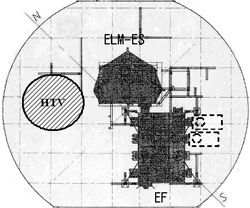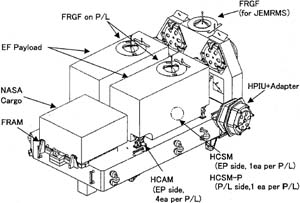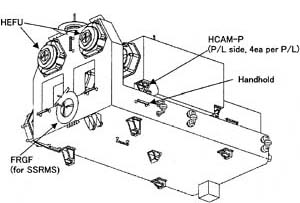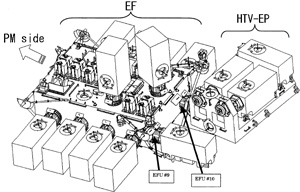 |
|
| Astronaut Wakata conducting the
test |
|
 |
|
| OPS #5 full view |
WETS exterior |
|
Kibo's Extravehicular Activity (EVA) procedure development test No.
5 (OPS #5) was conducted in the Weightless
Environment Test Building (WET) at Tsukuba Space Center (TKSC)
from November 17 to 22, 2003.
The purpose of the OPS #5 is to perform the procedure development*1
and design validation*2 of Kibo, the Japanese Experiment Module, and
of H-II Transfer Vehicle (HTV), which is now being developed by Japan
for transporting cargo to the ISS.
*1: In procedure development, procedures are developed
in advance for on-orbit assembly and maintenance of the ISS.
*2: Design validation seeks to validate whether Kibo has been designed
to accommodate EVA maintenance activities.
 What is OPS
#5? What is OPS
#5?
Kibo's elements will be launched to orbit in the years 2006 and 2007
in three Space Shuttle flights and will be assembled using the manipulator
and EVA.
This test is conducted to establish more efficient Kibo assembly EVA
procedures by confirming the details, such as assembly order and how
the EVA astronauts move, and the time needed for these operations.
The purposes of this test are to develop the procedures related to
Kibo Experiment Logistics Module Exposed Section (ELM-ES) and its onboard
Exposed Facility payloads, and to establish EVA on-orbit assembly procedures
after the launch of the ELM-ES. It also seeks to confirm the validity
of EVA procedures for the Un-pressurized Logistic Carrier (ULC) of
the H-II Transfer Vehicle (HTV).
In this test, astronauts in underwater space suits* confirm and validate
assembly procedures using a full-scale mockup of Kibo and related tools
located in the water pool in the Weightless Environment Test building
(WET) in TKSC.
*An underwater space suit is a normal space suit remodeled
for underwater use.
| HTV Operation |
 |
 |
 |
 |
 |
| HTV Launch |
HTV exterior |
Inside HTV |
HTV approaching ISS |
HTV Disposal (re-entry) |
| HTV, which will be launched by the
enhanced H-IIA Rocket, is a transfer vehicle to transport materials
such as supply goods and various equipment to the ISS, and to return
with spent equipment, used clothing, and other waste materials
on the return trip. |
 Description
of OPS #5 Description
of OPS #5
 |
| Layout of the mock-ups (Seen from above the pool.) |
OPS #5 will be conducted to validate EVA procedures related to Kibo's
ELM-ES and Un-pressurized Logistics Carrier (ULC) of the HTV. JAXA
astronaut Wakata and NASA astronauts Leroy Chiao and David Wolf will
participate as test subjects.
Astronauts work in the pool for three to four hours each day.
 Kibo-Related
tasks Kibo-Related
tasks
The primary verification procedures are as follows.
- Retest task after the design change
Parts that have had a design change since the last test must be reconfirmed.
The procedure will be verified by removing the Small Fine Arm (SFA),
which is a part of Kibo's remote manipulator system (RMS), from
the SFA Transportation Container (STC) on the Kibo ELM-ES.
- Tasks yet to be conducted in the Weightless Environment Test
The following procedures are planned to be conducted.
- Removing the thermal insulation cover of Inter-orbit Communication
System-Exposed Facility subsystem (ICS-EF) on ELM-ES.
- Releasing the launch locks of ICS-EF on ELM-ES.
- Separating the End Effector (EE) of Kibo's Remote Manipulator
System from the Grapple Fixture (GF) on ELM-ES in case of an
emergency.
- Releasing the launch locks of payloads aboard the ELM-ES.
- Contingency release of the Payload Attachment Mechanism (PAM)
of the ELM-ES when a failure occurs.
- Contingency separation of the Payload Interface Unit (PIU)
if a failure occurs while attaching the ELM-ES and Exposed Facility
(EF).
 HTV-Related
Tasks HTV-Related
Tasks
The primary validation procedures are as follows.
- Contingency separation of the EE of Canadarm 2 (Space Station Remote
Manipulator System: SSRMS), which grapples Unpressurized Logistic
Carrier's (ULC's) grapple fixture.
- Contingency separation of HTV carrying ULC to separate the EE of
SSRMS.
- Contingency separation for the failure of latch release mechanism
in removing the HTV-Exposed Pallet (EP) from ULC.
- Contingency separation for the failure of Tie-down / Separation
Mechanism (TSM) and Harness Separation Mechanism (HSM) in removing
HTV-EP from ULC.
- Contingency tie-down for the failure of lock mechanism in inserting
the HTV-EP into the ULC.
 |
 |
| Examples of HTV Exposed Pallet. |
 |
 |
| Partial full-scale mockup of HTV used in the test. |
HTV-EP connected to the Exposed Facility. |
 Press Conference Press Conference
The testing was opened to the press on November 19, 2003, with astronaut
Wakata in the underwater space suit conducting the test and astronaut
Hoshide providing an explanation.
 |
|
Briefing was held for the press before
the testing (from left: Mr. Matsueda, astronauts Leroy
Chiao and Hoshide)
|
|
 |
Astronaut
Hoshide giving explanation to the press
|
|
 |
Astronaut
Wakata
|
|
 |
Astronaut
Wakata getting into the pool
|
|
|
|
|





